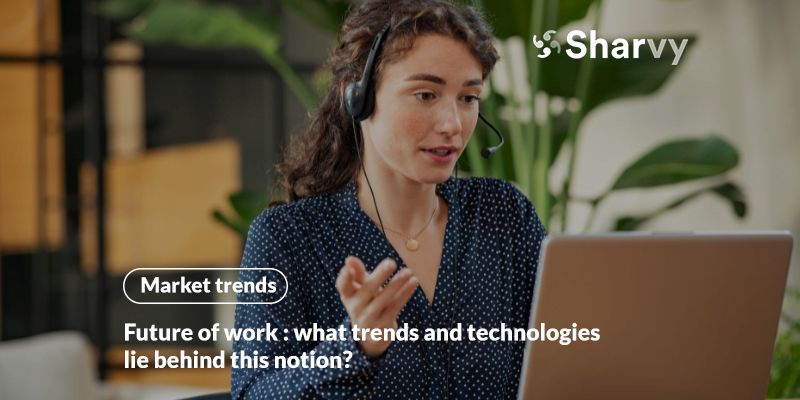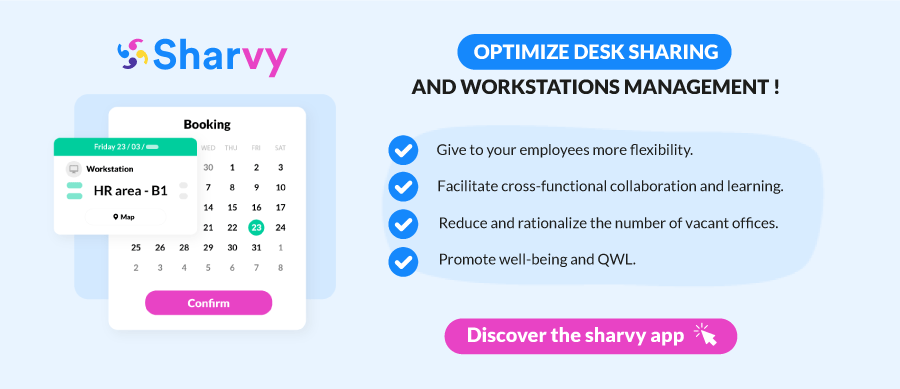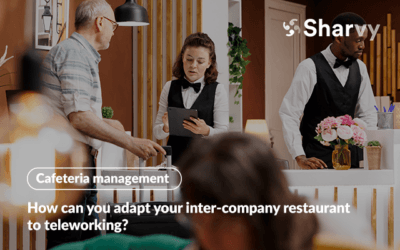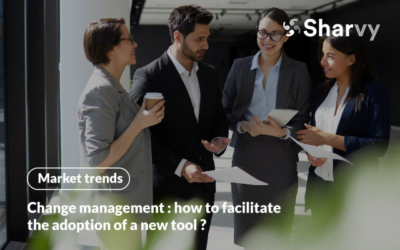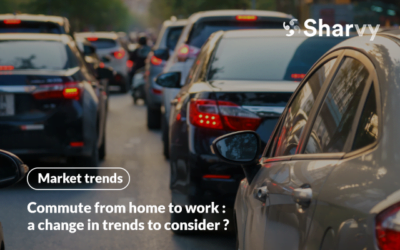At a time when global economic growth is at half-mast, shaken by the Covid-19 crisis, and when the new generation is asserting its intransigence on social, environmental, and ethical issues, the evolution of work is being questioned.
While the “Future of Work” theme feeds many (often alarmist) fantasies, it is time to deconstruct these visions to restore confidence and question future opportunities.
So, between utopia and dystopia, what can managers expect, and how can they prepare for the future? In this article, we discover 5 trends and technologies hidden behind the “future of work” and then draw out the implications for tomorrow’s professional world.
Future of work : what is it all about ?
“Future of work” has become part of the everyday corporate vocabulary. It’s a curious expression, given that no one can confidently say what the future of work holds for us… Nevertheless, it’s clear what lies behind this imperfect expression : a changing world of work and the emergence of new trends shaping the working environment as we move into the future.
Ultimately, this expression encompasses the impact of technological advances, economic transformations, new working methods, and changes in society. At its source : the eternal problem of talent management and turnover.
This is one of the reasons why the expression “Future of work” appeals to the curiosity of managers. Not only do they want their companies to remain competitive, they also want to retain their talent.
However, to prepare for the challenges and opportunities ahead, employers must know what changes to expect… That’s what we’ll find out in this article.
What are the 5 major trends in the “Future of work” & their consequences?
1. The golden age of hybrid work
Obviously, there is a “before and after” Covid-19 in the workplace. While in the past, in the minds of many employees, presenteeism was seen as a sign of commitment to the company, leading to the “FoMo” syndrome (Fear Of Missing Out), the reality today is quite different.
The crisis has merely revealed a turning point by forcing the population into confinement. Now is the time for reflection and awareness.
So, once the crisis was over, they wanted nothing more than to retain their sense of well-being and the many advantages of teleworking : less physical fatigue, greater concentration, no more commuting constraints, greater autonomy and, of course, a better work-life balance.
This is why more than 25% of them would consider changing companies if they felt their employer needed to be more flexible regarding work organization, according to this European study.
But, while the era of 100% face-to-face working seems to be over (47% of employees consider teleworking a sine qua non in their choice of company), employees are not looking for 100% remote working either, but for a happy medium : two to three days of teleworking.
✔ Let’s draw the consequences :
Hybrid working is having a significant impact on office occupancy rates. Companies are bitterly observing many vacant spaces for which they are paying a high price. As a result, nomadic working is gaining ground dramatically, gradually reducing the importance of the fixed workstation.
Faced with this phenomenon, and as there is no turning back, it’s time for companies to reinvest more strategically. This is where flex-office comes into its own and is beginning to make inroads into our offices. Given its advantages, it’s easy to understand why companies opt for it.
Want to find out more? Download the IRD experience report! Thanks to the Sharvy application, the transition to a flex office went smoothly and without a hitch, as did the introduction of a 0.8 overcrowding rate (i.e. : 8 workstations for every 10 employees).
2. Workspitality : hotel-style offices ?
There’s no doubt about it : with the rise of teleworking, one of the many challenges facing companies is to ensure that employees are happy to return to the workplace. And the key to this is the working environment. It has to be just as good, or better than home.
In this context, the concept of “Workspitality” appeared. It results from the contraction of “Work” and “Hospitality“. It refers to integrating workplace hotel codes (comfort and services).
As a result, and as we move into the future, offices will reinvent themselves and change their face. They will be more collaborative, more creative, and more user-friendly. In some forward-thinking companies, we’re (already) seeing this trend : no more grey (and depressing) color schemes and cramped offices.
In the future, most companies will redesign their workspaces to create a “lounge and cocoon” atmosphere, just like at home. Offices will also incorporate a range of value-added services combining hospitality and comfort. These will include, for example : a gym, dry cleaning, childcare facilities, a relaxation area, a click&collect, etc.
✔ Let’s draw the consequences :
However : since happiness is subjective and not a business issue, managers will gradually be obliged to employ someone full-time to carry out these tasks. As a result, new professions will flourish. One example is the Hospitality Manager, who is responsible for ensuring the comfort of employees and improving the Quality of Life at Work (QWL).
At the same time, there is also the Workplace Manager and the Office Manager. They are responsible for creating and maintaining an efficient working environment for all employees. And they have to bear in mind that an optimal workspace cannot be one-size-fits-all but has to be plural to respond to each employee’s individuality. And yes, because plural personalities require plural workspaces. As a result, these new professions, which are gradually emerging, will offer companies and workspaces new designs involving an inclusive approach and the ability to listen to employees’ needs.
3. Smart building : at the crossroads of the digital and energy revolutions.
As Emmanuel François, CEO of the SBA association, points out : “At a time when buildings and transport account for 70% of greenhouse gas emissions, offices can no longer be energy guzzlers“.
That’s why companies must use technology to enhance energy performance, employee experience, and work organization.
Ultimately, these are the objectives of “Smart building“. The technologies used are based on IoT and AI and apply to four key areas : monitoring energy consumption for heating and lighting, air quality and ventilation in the building, security, and digitizing user paths to make daily working life more fluid.
Workspaces will be the 1er to exploit the full potential of “Smart building“. To be more precise, we could even talk about the “Smart office“. That’s right, because with new trends and the advent of hybrid working, office attendance, for example, needs to be monitored (more) to enable companies to meet new expectations and thus adapt to the occupation of spaces. How can this be done? By installing various sensors, for example. These will enable companies to detect, through infrared movements, the number of people at their workstations and in their meeting rooms. Employers and/or Workplace Managers will then be able to identify precisely which spaces are used and which are not.
As a result, the objectives and benefits of “Smart building” are manifold : better distribution of people within spaces, regulation of ambient air, switching off lights if spaces are not in use, informing people of the availability of a meeting room, reconfiguring an area if it is noticed that it is very rarely used, as well as planning the correct number of meals in the company restaurant to avoid food waste, etc.
✔ Let’s draw the consequences :
While the number of “smart buildings” continues to grow, there are (to date) few standards governing the cybersecurity of these buildings. And let’s face it : cyber threats represent a real danger for years to come. It’s easy to imagine a hacker taking control of a building…
At the same time, there are functional risks. Today (and even more so in the years to come), AI is present at all levels of the building (control, access, alarms, etc). However, AI algorithms need to be regularly updated. In the event of a failure, it is the operation of the entire building that is at risk (deficient access control, users trapped inside the building, alarms out of order, etc). As a result, the risks of cessation of activities are all the greater with a “smart building” than with a conventional building, which does not have these kinds of issues at stake.
This is one of the reasons why new professions are springing up, with a wide range of issues at stake : Workplace Managers, Office Managers, Hospitality Managers, and so on.
4. Well-being is a key aspect of the “Future of work“.
There’s no doubt about it : for some years now, the future of work has been moving towards well-being, freedom, autonomy, transparency, and flexibility at work.
Paradoxically, however, we are seeing that changes in working patterns are accompanied by new “ill-being” factors that employers need to consider : moral harassment, professional stress, burnout, boredom, demotivation, loss of meaning, and so on.
That’s why companies must adopt an HR policy that focuses on improving well-being and working conditions. Silicon Valley start-ups are pioneers in this field, offering their employees greater freedom and a less formal layout of the workspace.
✔ Let’s draw the consequences :
In the years to come, well-being in the workplace will play a key role in corporate strategies. It will be a significant factor in competitiveness, a robust growth lever, and a formidable human resources management tool for companies.
However, employers should bear one thing in mind : the best ideas are based on the reality of the company’s situation. Building a gym only makes sense if your employees’ main problem is a lack of cohesion.
The emphasis should be on in-depth changes rather than “cosmetic” projects. For example, reorganizing offices, offering telework if this is not the case, offering various services similar to hotel codes, etc. Whatever the case, it is in the company’s interest to improve well-being at work to ensure its long-term survival and development.
5. Is the CSR approach driving the “Future of work” ?
It’s a well-known fact : it’s time for the “name and shame“, for whistleblowers, for NGOs to raise their fists, and for calls to boycott various products that are incompatible with the principles of sustainable development. Small and prominent media outlets are taking up the cause, and petitions are increasing on social networks.
As a result, consumers are increasingly well-informed and picky before buying a product. The proof : consumption of sustainable products is exploding, and eco-labels are following suit.
The conclusion? Companies are interested in responding to this demand for responsibility. Not only to ensure the long-term future of their business but, above all, to enhance their reputation and attract new customers.
Undoubtedly, the (successful) companies of tomorrow will be those that have succeeded in placing CSR values at the heart of their business model. Taking account of the expectations of all the company’s stakeholders (customers, employees, suppliers, etc.) is becoming the new business model to adopt.
✔ Let’s draw the consequences :
In the future, companies that incorporate CSR values into their strategies will undoubtedly be more attractive (from every point of view). Whether recruiting talent or attracting customers, suppliers, and investors.
Today, it is not uncommon for tender documents and grant applications to include a section dedicated to CSR, in which the applicant company has to show its credentials with convincing indicators!
What technologies lie behind the notion of the “Future of work” ?
How can we talk about the future of work without mentioning new technologies? They are at the heart of this revolution.
The question is no longer whether these new technologies will change the world of work (the answer is obvious), but rather how they will be integrated into the daily lives of employees and corporate strategies.
While some pessimists predict the destruction of all jobs and idle human beings, the “Future of work” is a far cry from this. Let’s discover what advantages these new technologies offer companies and their employees.
1. Disruptive technologies for your HR teams?
Does the stereotype of the machine replacing the “human resource” in the world of work sound familiar? No wonder. But does it represent reality?
The time has come to question the adage that technology and humanity are two distinct domains if not outright opposites. Our vision is as follows : the right technological tools make it possible to (re)place people at the heart of the company’s activities.
And on this point, it’s well known : HR managers are experiencing the full force of the changes in their profession. For HRDs, one of the significant challenges of the “Future of work” is to lead and support the changes brought about by technological change. They will need to take advantage of new, ever more efficient technologies, for example, by automating many processes using an HRIS tool.
At the same time, HR applications must be transformed to meet new needs, and the user experience will become the focus of attention. As a result, HR will have an impressive amount of information at its disposal (Big Data), and making the most of it will undoubtedly become a significant challenge. Data relating to time management, planning, project feedback, etc., can be cross-referenced for various purposes. They will need to be able to analyze it correctly (through reporting and business intelligence) while complying with the regulations in force.
2. Automation is the key to higher-added-value assignments.
There is no doubt that the automation of processes should, more than ever, be at the service of businesses. On the one hand, this technological advance will help to free up precious time for employees. They can concentrate on higher value-added tasks by freeing them from time-consuming, non-value-adding tasks.
At the same time, companies often need help to speed up project turnaround times. Mainly when these projects involve large teams working simultaneously across multiple sites and/or time zones, by automating processes, these teams will be able to monitor the progress of objectives in real-time. They will also be able to take account of bottlenecks at every stage of the process, and why not let Artificial Intelligence (AI) make the necessary corrections?
As a result, the rise of automation offers companies greater efficiency and enables them to streamline their operations while saving money – a win-win situation.
3. Integrating Machine-Learning for even greater agility.
Have you ever watched a video in the suggestions section of your YouTube account? Or have you ever noticed the effectiveness of your smartphone’s automatic proofreader? If so, you’ve benefited from several applications of Machine Learning.
In other words, Machine Learning involves algorithms finding “patterns” in the data and then predicting the likely outcomes.
For example, this is the case when you receive an e-mail. Your e-mail provider will analyze the words in the subject line, the links, etc., and then classify the e-mail as either spam or legitimate. Following this analysis, it will rank the e-mail as either spam or legitimate mail in your inbox.
One of the most significant advantages is that, over time, the algorithm can “learn and adapt” its results according to new information.
This advance can be beneficial for identifying new and unknown threats more quickly than humans. As a result, and thanks to Machine Learning, many IT risks (phishing, spam campaigns, etc.) can be detected and avoided quickly, allowing employees to work with peace of mind.
The efficiency this technology promises would enable companies to meet many challenges and, above all, to remain proactive.
4. Artificial Intelligence (AI) to help you develop your talents.
The further we move into the future, the more companies are aware that AI is going to play an important role in talent and skills management policies.
Companies are (increasingly) seeking to place their employees in a situation of continuous development and learning. However, this presupposes collecting, controlling, measuring, and bringing together a range of parameters, in particular :
- Everyone’s skills.
- The skills required today.
- Employee expectations.
- The skills needed in the future.
- Training courses available.
- In-house trainers specialized in each skill.
- Possible tutors, etc.
The list is (of course) incomplete. But in other words, it’s a complex issue of collecting, managing, and linking data. A set of tasks that Artificial Intelligence can be particularly adept at accomplishing.
5. Internet of Things (IoT) : a technology creating new opportunities.
The IoT has a great future ahead of it. The growth of this technology is undeniable, particularly in sectors such as logistics, agriculture, and public services.
However, the IoT is also at the heart of the smart office, and there is no doubt that this technology improves well-being in the workplace and working conditions. Here are 2 examples :
- IoT improves access to company car parks : parking experience (for employees and visitors) are essential elements companies must pay attention to! However, there are (still) queues at the rising barriers in some company car parks and a problematic and/or slow means of identification for users. Integrating IoT technologies such as badge readers, RFID cards, and number plate recognition cameras can make it easier and more fluid for employees and visitors to access your business. What’s more, these devices are very easy to install and operate. The Sharvy application can be your right-hand man in this respect, improving the parking experience for your employees. If you’re curious to find out more, go here.
- IoT technologies are making it easier to book workspaces : as we saw above, hybrid working, alternating between teleworking days and face-to-face days, is also speeding up the introduction of the flex office. However, your employees will often be reluctant to change their routine during a transition. They will tend to want to come in more than usual, leading to over-occupation of your premises. In the long term, a lack of organization can lead to too many staff on-site on the same day. To avoid this, adopting the IoT and a dedicated solution improves the employee experience and undoubtedly facilitates the transition to a flex office. Your employees can anticipate their needs several weeks in advance by reserving a workstation and/or freeing up an assigned workstation in anticipation of an absence. These digital solutions can also be interfaced with various day-to-day tools : HRIS, access control, authentication, etc. This helps to improve working conditions for everyone.
So, the IoT is a technology that creates new opportunities for managers and employees alike. It is, therefore, not to be overlooked in the context of the “Future of work” and the smart office. So if you too want to take the plunge, request a demonstration of this type of solution here.
In conclusion
After reading this article, it’s easy to see that changes in the world of work are creating both challenges and opportunities for businesses.
Far from representing a break with the past, these changes reflect trends already underway for the last ten years, catalyzed by the health crisis. New businesses, new tools, and new working methods have emerged, supported by the digital maturity of our society.
One of the main lessons for managers? Undoubtedly, by exploiting technology while focusing on people, it is possible to offer innovative working methods that (really) help employees to remain productive, despite the upheavals of today’s world, enabling the business to prosper.
Thus, technological advancements and new trends in the Future of Work are redefining traditional workplace paradigms. By embracing automation, artificial intelligence, and the Internet of Things, companies are not only meeting the demands for modernization; they are also creating spaces where the efficiency and well-being of employees are optimized. These technologies are not just tools but catalysts for a deeper transformation that promotes a culture of collaborative, flexible, and resilient work. In doing so, they position businesses at the forefront of innovation and competitiveness in an ever-changing world.
Want to learn more? Check out the latest articles!
How can your inter-company restaurant adapt to teleworking?
Teleworking : how can you manage the number of people using your inter-company restaurant & adapt your offer to new working habits? Focus.
Change management : how to facilitate the adoption of a new tool?
What are the essential steps to facilitate change management in your company ? Our advice and best practices can be found here.
Commute from home to work : a change in trends to consider ?
Commute from home to work : what trends can be observed? What are the risks? How can they be improved? Focus in this article.
Subscribe to our newsletter!
Resources
Contact us
+44 117 463 6990

